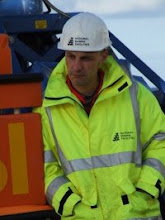(WARNING technical stuff inside!)
A few people have asked why we are here (no, not in the philosophical sense... although some of us on board maybe wonder about that at times)... no, I mean why is the ship here off the coast of Chile? What do we hope to achieve? what are the aims and goals of the science we are conducting... why are we HERE...

RRS James Cook
Well I did think about writing a long winded and boring description of all of the above but then I thought to myself, hey, surely these clever German chaps will already have done something... A quick google search led me to the site linked at the top of the page where I blatantly cut and pasted the following from...
SFB 574 Cruise “JC 23” with the British research vessel James Cook is scheduled from March 3 to April 18, 2008, devoted to geophysical investigations of the area offshore Southern Chile. During the first leg, which will be led by Prof. Ernst Flueh, a short-period seismic network will be set out at the outer rise, and combined onshore-offshore wide-angle and seismic refraction data will be gathered along trench-perpendicular transects deploying OBS . The second leg, under leadership of Dr. Joerg Bialas, will be used for mapping work, as well as for recovery of the short-period stations, which will be replaced by broadband stations supposed to operate till October, 2008. The major goal of this seismic and seismologic work is to better understand the influence of serpentinisation on the subduction process and the release of fluids. The findings will be integrated with data from a land-based seismic network of about 60 short-period and broadband stations in the adjacent area, which is being established in cooperation with our Chilean partners.
So I hope that makes things a bit clearer? it doesn't? no, me neither... Ernst...!?
Okay, so what are we actually doing then? well basically as I mentioned in an earlier post we are deploying a whole load of OBS' onto the ocean floor in a predetermined pattern (worked out by those clever chaps at Geomar) and once we have put them down we turn back over the line, deploy some bloody great airguns and steam back over the top of them banging away every 60 seconds. We then bring the guns in, recover the OBS' and redeploy them on the next line and repeat the process. This will happen over three lines and then we will recover most of the OBS (some will stay down until October) and head back to Valpo to change around for the 2nd leg of the cruise.
What is an OBS and why do we use it?
Seismometers measure movement in the Earth's crust. About 90 percent of all natural earthquakes occur underwater, where great pressure and cold make measurements difficult. The ocean-bottom seismometer (OBS) was developed for this task.
Scientists use seismometer data to calculate the energy released by earthquakes, like the massive one in December 2004 that caused the Indian Ocean tsunami. By using sensitive seismometers to study small earthquakes, researchers are working to predict large earthquakes or volcanic eruptions.
Other scientists use seismometers to peer inside the Earth itself. The waves that earthquakes generate get deformed or slowed down as they pass through different materials inside the Earth. Seismometers equipped with precise clocks record the shape and speed of these waves when they arrive. After an earthquake, data from many widespread seismometers help geologists to calculate the structure of Earth’s mantle and crust.
How does it work?
Seismometers work using the principle of inertia. The seismometer body rests securely on the sea floor. Inside, a heavy mass hangs on a spring between two magnets. When the earth moves, so do the seismometer and its magnets, but the mass briefly stays where it is. As the mass oscillates through the magnetic field it produces an electrical current which the instrument measures.
The seismometer itself is a small metal cylinder; the rest of the footlocker-sized OBS consists of equipment to run the seismometer (a data logger and batteries), weight to sink it to the sea floor, a remote-controlled acoustic release and flotation to bring the instrument back to the surface.
Ok that's quite enough of the boring science lesson, here's some pictures of an OBS recovery carried out this afternoon;

Charlie & Wiebke recover the OBS

And once on deck it is surrounded by scientists
Tomorrow there is more of the same with the aim being to finish the second line of deployments tomorrow night and to be ready to put the guns out again early the following morning... Deep joy! another 30 hours of pounding to look forward to then (if you want to know what this is like check out Dan's blog, boomin heck by following the link over there~~>). Oh well, at least tomorrow night will be quiet (hopefully)
Mick
 Multibeam is an acoustic technique used for the production of bathymetric and sediment classification maps. Different sonar models are classified according to the following parameters:
Multibeam is an acoustic technique used for the production of bathymetric and sediment classification maps. Different sonar models are classified according to the following parameters:  A C-View Bathy 3D swath bathymetry image showing clearly a gas pipeline draped over reef
A C-View Bathy 3D swath bathymetry image showing clearly a gas pipeline draped over reef









